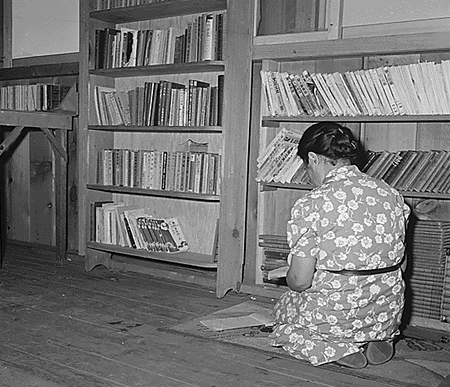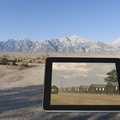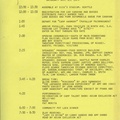Read Chapter 3 (1) >>
Community libraries as seen through camp newspapers
Initially, each camp published a mimeographed newspaper, which played an important role in delivering everything from notices from the WRA to community news to each household. The WRA also subjected this newspaper to thorough censorship three times: when the manuscript was compiled, when it was written on wax paper with a stylus or typewriter, and when it was printed. Manzanar had a newspaper called the Manzanar Free Press, but one inmate resented it, saying, "What kind of free press is this? The only thing that's free is that the newspaper is free, there's no freedom of speech." However, it was an indispensable source of information, such as which household had a new baby, and when outdoor movies and concerts were scheduled at the library. In this article, we will explore the origins of the community library through this community newspaper.
First, regarding the libraries in the camp, the WRA hired a librarian from outside as a project librarian. This librarian was to oversee the school library and community library in the camp, and also serve as the high school librarian. The community library contained an English library and a Japanese library, and a Japanese-American served as the librarian in the Japanese library. Exhibitions of paintings, flowers, and crafts were held, and music appreciation evenings were also held, creating a cultural space where the destitute internment camp residents could forget about their boring life.
What is the most popular book in the camp? —Summer
What kind of books were they? According to Mabel Ota, a librarian at the Poston Community Library, the most popular were the refrigerated books. 1 When I first saw this article, I thought it was a joke. If you were put in a concentration camp, would you want to read a refrigerated book? Newspaper editors sometimes included light humorous articles to spice up the monotony of camp life, so I thought this might be the same. And so it goes.
<The lost child - turns away from his father's cooking and goes to a new restaurant>
Virginia Fujii, 2, of barrack number 33-13-4, and her neighbour Kingo Hankawa, 2 1/2, went missing last Sunday morning, causing two tense hours for both parents.
...Police were called in to search for the missing children and thoroughly searched the camp. The two children were finally found around noon, quietly eating lunch at Canteen 21. Virginia's father, Mac Fujii, works at Canteen 33 and is a little upset that his children have given up on his father's cooking for another restaurant.
So, I had been thinking about the book on mechanical refrigeration for a long time, and it turned out to be true after all. In the same state of Arizona, about an hour's drive southwest of Phoenix, the Gila River Internment Camp was set up on a Native American reservation, where the average summer temperature reaches 40 degrees Celsius, sometimes reaching 52 degrees Celsius. For this reason, the camp has a double-layered roof. Even so, it is difficult to endure the heat, so they make air conditioners out of whatever is on hand. Other internment camps must have read the book on mechanical refrigeration and devised their own air conditioners. I found the following passage in Gene's book.
To beat the summer heat, most homes installed air conditioners. These consisted of a box-shaped wooden frame covered with a straw mat. Water was poured over the mat and an electric fan placed inside the frame was turned on, drawing outside air into the room through the gaps in the water-soaked straw. This was an extremely effective cooling method. 3
To increase the collection of books : From summer to winter
In August, with its opening soon approaching, the Poston Second Library placed a request for borrowing in the camp's newspaper in an attempt to increase its collection. This was an attempt to ask everyone to lend books to the library on a special basis. The books borrowed by the library would be bound and stored in special shelves, and would be handled with the utmost care for use only within the library. 4
At the Minidoka Internment Camp, Hiroshi Nagai, a first-generation Japanese who worked as a book collector, had an idea. He wanted to create a Japanese language library for the many first-generation Japanese, using the Japanese books that had been confiscated at the Puyallup Internment Camp as a core. He made the following appeal in the camp newspaper dated October 14, 1942:
The books confiscated in Puyallup are currently being transported to Minidoka. We can return them to you, but we would appreciate it if you could donate them to the Japanese Language Library. If you would like to donate any books that you left behind in Seattle when you were evicted, we will cover the postage costs.
This appeal may have been successful, as the Japanese language library opened on December 8th at Minidoka. It was open every day from 10am to noon, 1pm to 5pm, and 6pm to 8pm. At the time, the shelves were lined with about 1,000 books, including classics, novels, religious books, poetry, and philosophy books. The library had a capacity of about 10,000 people, and assuming that about 70% were second-generation Japanese, 3,000 were first-generation Japanese. The second-generation Japanese who had returned to America also needed Japanese books, so the first 1,000 books probably disappeared from the shelves quickly. Efforts were made to increase the library's collection. "If each household could donate one book, our collection would increase by 2,000 books. We appreciate your help," said Librarian Nagai in a newspaper dated January 9th, 1943. At that time, he added that he had recently received a donation of "Pirate" by H. Inouye from Hashiguchi , "Kodan Club" by Seiji Noma from Dozen, "History of Imin" by Mori, and "Until the Equinox" by Natsume Soseki from Makino.
Meanwhile, Alice Frost, head of adult education at Seattle Central Library, received a letter from Principal Wright of Hunt High School in Minidoka, asking about the supply of books for the school library and adult school in the camp, and sent 100 books to Minidoka at the end of October with some donated books. Principal Wright also inquired about books written in Japanese, and Frost decided to lend out all 173 Japanese books in the library until the camp was closed, saying, "Since all the Japanese people in Seattle are in Minidoka, and there is little space for books in the library, it makes sense to send all books written in Japanese to the camp." On November 21, when the shortage of coal for stoves reached a critical point, Japanese books arrived from the Seattle Library, but Frost learned from a letter of thanks from Principal Wright that these books had also gone through a lengthy process of being submitted to a censorship committee in the camp, and the list of books approved by the committee had to be sent to the WRA headquarters in Washington, DC, where approval also had to be obtained. 6
Notes:
1. The Poston Information Bulletin, Vol. I No. 21, June 5, 1942.
2. Manzanar Free Press, Vol. II No. 7, August 5, 1942.
3. See above, "Torn Identity: The Life of a Japanese-American Journalist"
4. Poston II Official Daily Press Bulletin, Vol. III No. 17, August 11, 1942.
5. The Minidoka Irrigator, Vol. I No. 9, October 14, 1942.
The Minidoka Irrigator, Vol. I No. 25, December 9, 1942.
The Minidoka Irrigator, Vol. II No. 3, January 9, 1943.
6. Seattle Public Library Departmental Reports 1942.
*Reprinted from the 135th issue (October 2013) of the quarterly magazine "Children and Books" published by the Children's Library Association.
© 2013 Yuri Brockett







